Hope flows forth from Marawila’s ‘Kurusa Palliya’
Silent but intent are the men, women and children who raise their eyes in prayer and pleading, to the life-size statue of Jesus Christ hanging on the Cross, looking down on them benevolently.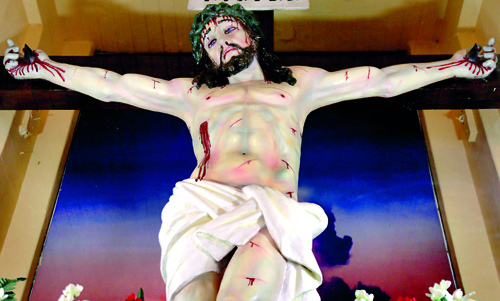
While some sit cross-legged or kneel with arms outstretched on the sandy-floor in this simple and spartan shrine, others drag themselves on bended knee along the narrow concrete pathway leading to it.
They murmur their prayers, make a vow or light a few candles and go on their way, for the whispers of “prathihara and haskam” (miracles) which have been coming down the years, have in recent times become a loud call, drawing more and more faithful to the humble ‘Kurusa Palliya’ (Holy Cross Shrine) on the Marawila wella (beach) with glimpses of the blue sea over the low wall.
Crowds and not only Catholics but from all religions and not just from Marawila but from across the country stop by at the Kurusa Palliya to look in wonderment at the line-image of Christ’s face visible on the stomach of the statue. The shrine is open throughout the day and night and some come in for a quiet moment even early morning around 2.
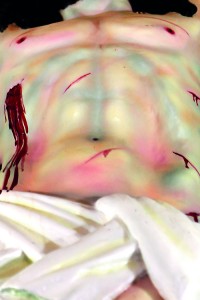
The outline of Christ’s face on the stomach
It was about six months ago that Marawila Parish Priest Fr. Ivan Peter Fernando wanted a new coat of paint for the beautiful statue of the Kurusa Palliya.
Unlike the opulence of big churches, the simple structure which is home to the statue of Christ on the Cross is surrounded by tombstones. Burials still take place here as it is the ‘grave-yard’ of the Church of Our Lady of Presentation just up the road about 350 metres away. The church had been consecrated way back on February 1, 1875 and the grave-yard established two years later on April 15, 1877.
When Fr. Ivan saw the newly-painted statue of Christ that evening last year, he had not been too 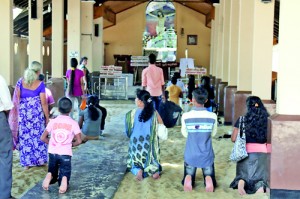 satisfied because it looked very white. That was when he told the painter that he would take a look the next morning, as the evening shadows may be playing a part in creating a strong white hue. Next morning, he decided it was not too bad and to let it be.
satisfied because it looked very white. That was when he told the painter that he would take a look the next morning, as the evening shadows may be playing a part in creating a strong white hue. Next morning, he decided it was not too bad and to let it be.
Frequented not only by migrant fishermen and those living in Marawila who say a quick prayer before the ‘Big Fisherman’ — as Christ is known as He taught his disciples to be fishers of men — seeking a good catch and safe sea-faring, it had been one of them who had about two months later witnessed the outlines of the face on the abdomen and rushed to the church to alert Fr. Ivan of this “sign”.
When asked whether it could have been painted, Fr. Ivan states categorically that people who visit the Kurusa Palliya make their own judgment and all of them declare that the face has appeared as a sign of hope.
In fact, the Sunday Times learns that many people are of the view that miracles have been taking place long before this and that is why the Chilaw diocese has the privilege of having two national shrines instead of the usual one – St. Anne’s Church at Talawila and Kurusa Palliya at Marawila. Even President Mahinda Rajapaksa had visited the Kurusa Palliya last September.
The origins of the Kurusa Palliya statue are also surrounded by tales of awe. Just an ordinary church grave-yard which caused no waves among the populace from 1877 to 1921, it had been Fr. Ferdinand Thiri, a Frenchman, who was Parish Priest of Marawila from 1909 to 1924 who had ordered the statue of Christ on the Cross from Bangalore, India for Rs. 250. The money for the statue had been donated by parishioner W.W. Carolina Fernando.
Usually in most crosses, a familiar symbol in churches, the head of Christ drops down in agony, and the eyes are closed, but in this the eyes look down tenderly and with forgiveness on a world that has betrayed and rejected Him, crucifying Him.
This statue was to be shipped from Bangalore to the Port of Colombo and then brought by train to Nattandiya, from where Fr. Thiri and a group of devotees would bring it to Marawila, states Fr. Ivan, having pored over documentation of that time. However, to the dismay of all when the Station Master opened the crate, the statue had been in pieces and on his advice the church had been able to claim its insurance value of Rs. 250. When as was customary, the Railway Department auctioned the unclaimed cracked statue, Fr. Thiri had bought it for Rs. 2.50.
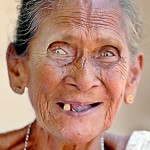 Josephine |
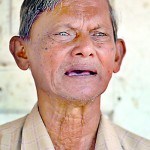 Sylvester |
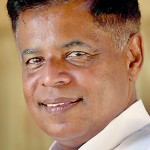 Fr. Ivan Peter Fernando |
On receiving the insurance money, Fr. Thiri had got a special badama (plaster) from Germany and glued the pieces of the statue together but unsure of its stability and fragility had decided to keep it at the Marawila church. It was not to be, for some inner voices had insisted that Fr. Thiri instal the statue at the grave-yard. This had been done with the statue being taken in a cart drawn by two bulls. With the balance insurance money, a small cadjan hut had been erected over the statue.
Fr. Thiri’s words to the crowd after the ceremony had been that they would see its miracles after he was gone, says Fr. Ivan, adding that his prophetic words had come true when the children of the area were assailed by a skin disease in 1947 and one desperate mother had prayed fervently at the Cross, washed the feet of Jesus with water and then headed for home to dab that water on the skin rash of her little one.
With healing taking place overnight, the whole community had flocked to the Kurusa Palliya to overcome the skin disease, says Fr. Ivan, as we walk around.
Numerous are the people whom we spoke to on Wednesday for whom there has been “help” from the Kurusa Palliya. They believe that miracles have occurred in their lives.
“All my son’s job problems were settled after our visit here,” says Jacintha, while her son distributes some buns among those in prayer.
Fr. Ivan recalls how a little child affected by Thalassaemia who was not walking, crawled three times around the kohomba tree in the yard, held onto it and then took a few steps as the child’s parents were talking to him. He had then requested the parents to come on the first Friday of the following month and the child was walking by then, he says.
We walk across to the home of mother and son, Josephine, 90, and Sylvester Fernando, 72, on the Marawila beach. One after the other they tell us about the miracles that have taken place. How Sylvester as a teenager was suddenly struck by an illness which confined him to bed, that both the western and ayurvedic doctors were unable to cure.
“They feared for my life and it was prayer at the foot of the Cross of the Kurusa Palliya that saved me,” he says, giving various other instances as well including the recovery of a child who had accidentally swallowed a broken blade.
A similar story we hear from Kalyani Perera, 57, who had severe thunatiya (back) pain after the tissues in that area were affected when she stretched to re-arrange some flowers. For 11 years she had been in immense pain, hardly able to walk, hobbling out of bed to do a little housework as she had two young children then, and dropping back into bed soon after.
“I tried western medicine and also ayurvedic kasaya and thel, but to no avail. Then I dreamt of Christ in a white cloak carrying the Cross and was healed thereafter,” she says, adamant that it came from the Kurusa Palliya.
One thing is certain – something keeps drawing people to this humble shrine, as another Good Friday passes and Easter Sunday dawns.
Betrayed, rejected and crucified was Jesus Christ — but was it the end of a tale of love and ultimate sacrifice 2014 years ago.
It does not seem so and the Kurusa Palliya holds out hope for those in despair. Hope of a cure, be it from an illness of the mind or body, hope of the lifting of an unbearable burden and also the promise of resurrection.
For many Kurusa Palliya is the embodiment of the living Christ.


